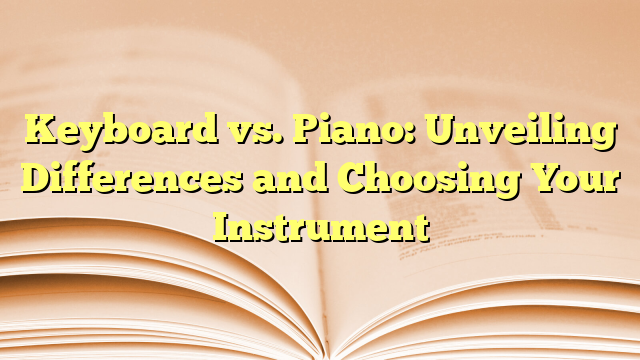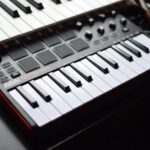Ever wondered if a keyboard is equivalent to a piano? I've often pondered over this, and I'm sure many of you have too. It's a question that sparks debate among musicians and enthusiasts alike.
In this article, we'll delve into the intricate differences and similarities between these two instruments. We'll explore their physical attributes, sound quality, and the skills required to play each. Whether you're a seasoned pianist, a budding keyboard player, or just an interested observer, you'll find this comparison intriguing.
So, let's get started! Is a keyboard really synonymous with a piano? Stay tuned as we unravel this musical mystery.
Physical Attributes
As we delve into the tangible distinctions, size and layout constitute major differences between keyboards and pianos. Now, a traditional acoustic piano usually boasts 88 keys, encompassing seven octaves plus a minor third. This layout has been the standard since Steinway designed it in the late 19th century. To contrast, the number of keys on a keyboard can significantly vary. You'll commonly find keyboards with 61 or 76 keys, but those with 25 or even 88 keys are not unheard of.
Looking at the weight and portability, keyboards take a significant lead here. Lighter in design and compact in size make keyboards a more appealing choice for traveling musicians or those with space limitations. Comparatively, moving a piano involves painstaking effort and logistics.
Next, let's talk about the touch and feel of the instruments. When you strike a piano key, it activates a hammer mechanism that hits the strings, creating sound. This action provides a weighted, tactile sensation that pianos are renowned for. Keyboards - or at least the lower-end models - often lack this touch sensitivity. Yet, many advanced keyboards do contain weighted key options that mimic the feel of a piano.
Peek inside the piano, and you’ll find strings and hammers, responsible for creating rich, resonant tones. Keyboards, on the other hand, use electronic sound-producing mechanisms. This difference affects not just the tonal quality (which we’ll explore later), but also the physical maintenance required. Pianos need regular tuning - a service not necessary for keyboards.
Throughout this section, I've addressed differences in the physical attributes, from size to sound mechanisms, between pianos and keyboards. This exploration helps to discuss further the sound quality and skill required for each instrument.
Sound Quality
Shifting gears for a bit, let's delve into the nitty-gritty of sound quality. Here, we'll discuss what makes a piano's sound unique and how a keyboard holds up in comparison.
The depth and richness of a piano's sound principally come from its strings and hammers. Each time you press a key, a hammer strikes multiple strings simultaneously, creating an incredible resonance that musicians adore. The soundboard, a vital component of a piano, amplifies these vibrations, leading to a rich and unique sound. Pianos have a diverse dynamic range, meaning the tone changes depending on how hard or softly you play. That adds another layer of expressiveness, enabling you to create a wide array of emotions through your music.
Moving on to keyboards, they utilize digital samples for their sound. This system allows an array of pre-recorded sounds to be played, ranging from classic piano tunes to other instruments like drums, violins, and much more. The sound is made by pushing a switch that sends a signal to produce the required tone. Due to this, keyboards are more consistent and predictable with their sound quality. They may not possess the dynamic range of a piano, but their versatility and variety of sound effects and tones are vast.
As we transition into the next section on skill required, it's important to keep in mind how these unique sound-producing mechanisms affect the techniques and approaches necessary for playing these two instruments.
Playing Skills
When it comes to mastering the finer points of playing, both the piano and keyboard have their unique challenges. You'll find that the same techniques don't always translate directly from one instrument to the other.
Subtle Nuances in Piano Playing
Piano playing requires an understanding of unique elements, largely due to its acoustic nature. For instance, the tone of a piano changes based on how hard or soft you press the keys, offering a rich, dynamic range of sounds. It's important to develop a precise touch as too much pressure can lead to a harsh, unpleasant sound while too little pressure won't be loud enough to carry the melody. It's all about mastering the right balance.
To excel in piano, you also need a robust understanding of pedaling. Piano pedals offer a degree of expressive control not found on many keyboards. By damping, sustaining, or modifying the instrument's tones, pedals can significantly impact the overall musical output.
Keyboard Technique Variations
On the flipside, keyboard playing brings its distinctive set of skills. Since keyboards are electronically powered, volume and tone adjustments are typically controlled via knobs or buttons. You don't have the same tactile feedback as a piano, which can be both a blessing and a curse depending on your perspective.
Keyboards stand out with sound versatility. They offer a wide range of tones, effects, and even the ability to replicate other instruments. As a result, keyboard players often need to be adept in programming and understanding their instrument's technical aspects, which can increase their versatility and musical potential.
One can't easily say that the learning curve for one is more daunting than the other. Understanding and mastering these distinctive musical elements, whether you're seated at a grand piano or standing with a portable keyboard, will surely enhance your abilities and widen your musical horizon.
The Debate
As we dive deeper into the discussion, it's clear the keyboard and the piano are drawn up to an intense battle on what's considered the real McCoy of music. It's akin to a duel of traditional versus modern, acoustic versus digital, natural resonance versus amplified sound, physical dexterity versus program utilization.
The choice to opt for a piano or keyboard is often subjected to certain factors. It can be personal preference, the style of music an individual wants to play, affordability, portability, and the kind of musical training one has undergone.
Let's take one for the piano– it's an acoustic instrument, unlike the keyboard. The sound produced is due to the natural resonance of the strings struck by hammers, creating an unrivaled depth of tone. A piano's richness in sound is unparalleled and it draws individuals who value authenticity and the intricacies of acoustic sound production.
In contrast, the keyboard thrives in the digital world. It's portable. It can reproduce a variety of sounds and musical styles, which serves to its advantage. Moreover, keyboards allow musicians to explore and experiment, offering a universe of possibilities with the myriad of tones and effects. The keyboard's versatility caters to a wide range of musical genres and styles. That too is something worth considering.
*Fact-based Comparison:
| Criteria | Piano | Keyboard |
|---|---|---|
| Sound Production | Acoustic | Electronic |
| Portability | Less portable | Highly portable |
| Variety | Limited to piano sound | Multiple sounds and effects |
| Learning Curve | Requires physical dexterity | Requires technical programming skills |
| Cost | Generally more expensive | More affordable |
Tying it all together, the difference in playing skills required for both the piano and keyboard, as previously discussed, further complicates this debate. It's vital to understand and master these unique musical elements—be it the tone changes based on key pressure and the use of pedals for expressive control in pianos or adjusting volume, tone electronically, and programming the instrument for sound versatility in keyboards.
Choosing the most fitting instrument is ultimately a decision based on individual needs and requirements. The debate, thus, remains subjective, much like the art of music itself.
Conclusion
So, is a keyboard equivalent to a piano? The answer isn't black and white. Yes, they share similarities, but they're unique in their own right. The choice hinges on what you're looking for in an instrument. If it's about portability and variety, a keyboard takes the lead. But if it's about sound quality and traditional learning, a piano might be your best bet. It's all about weighing the pros and cons, and choosing what suits your needs. Remember, it's not a competition between the two, but about finding the right fit for you. So whether it's a piano or a keyboard, what truly matters is the music you create.
Harlan Kilstein began playing piano during covid with no piano background at all. He taught himself how to play learning what to do and what not to do.
Today he's an advanced intermediate player and can help you grow in your skills because he learned all this on his own.








